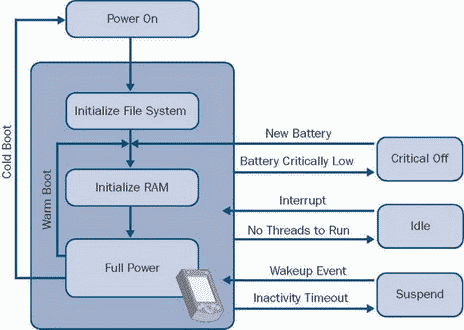Книга: Microsoft Windows Embedded CE 6.0 Exam Preparation Kit
Power State Transitions
Power State Transitions
Embedded devices that are not constantly in use, such as personal digital assistants (PDAs), operate for extended periods of time in an idle state, thus providing an opportunity to preserve energy by switching from full-power mode to a reduced-power mode or suspend state. Most embedded processors available on the market today support these transitions, as illustrated in Figure 5-9.

Figure 5-9 Power state transitions
Windows Embedded CE can respond to power-related events in the following ways:
? Battery critically low The system switches into Critical Off state in response to a nonmaskable interrupt (NMI) that a voltage comparator on the board triggers, so that the user can replace the battery and resume.
? Idle The system switches the CPU into reduced-power mode if the CPU has no worker threads to run and wakes up when an interrupt occurs.
? Suspend The system switches the device into Suspend state when the user presses the Off button or in response to an inactivity timeout and resumes in response to a wakeup event, such as the user pressing the power button again. On some embedded devices, the Suspend state corresponds to a true power-off state, in which case the system resumes with a cold boot.
- Supporting the Critical Off State
- Chapter 7. The state machine
- User-land states
- State match
- State NEW packets but no SYN bit set
- Конкурентный бенчмаркинг в GE Real Estate
- За пределами PowerPoint
- Testing Wdm2 Power Capabilities
- Глава 1. POWERPOINT – ЗЛО?
- Свойство WindowsState
- Conditional Statements
- Special Statements: for, while, and Others




